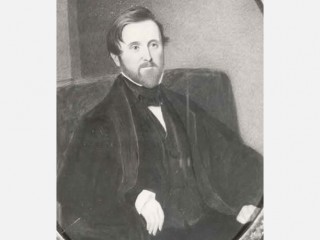
Alexander Davis biography
Date of birth : 1803-07-24
Date of death : 1982-01-14
Birthplace : New York City, New York, US
Nationality : American
Category : Arhitecture and Engineering
Last modified : 2010-11-18
Credited as : Architect, ,
Alexander Jackson Davis was a leading figure of the 19th-century Gothic revival in American architecture.
Alexander Jackson Davis began as an apprentice architectural draftsman to Josiah Brady of New York in 1826, though his early painting ambitions remained evident in his lifelong picturesque approach to architectural design. In 1829 Davis joined Ithiel Town in what became the first architectural firm of a modern sort in the United States, lasting until Town's death in 1844.
Davis specialized in domestic architecture, leaving more public or monumental commissions to Town. Hundreds of houses were built directly or indirectly from Davis's designs; he was also among the first architects to design furniture for his larger houses. He claimed to have been first to introduce to America "the English Gothic Villa with Barge Boards, Bracketts, Oriels, Tracery in Windows … in 1832" and also the Italianate villa, with a drawing exhibited about 1835. In the early 1840s Davis began moving into the orbit of A. J. Downing, illustrating Downing's book, Country Houses, in 1850. After Downing's death Davis designed and supervised all buildings in Llewellyn Park in West Orange, N.J., conceived by Downing and financed by Llewellyn P. Haskell as America's first "garden suburb" (1852-1869).
Picturesqueness was predominant in all Davis's works. Yet in his last major project, an unsuccessful submission in the 1867 competition for the New York City Post Office, he designed a metal and glass structure which clearly presaged 20th-century "functional" concepts. Far from being contradictory, however, both picturesqueness and functionalism were from the first inherent in the American—as distinct from English or French—Gothic revival.
In America, Gothic revival architecture never challenged the Roman or Greek revival in mass popularity; indeed, its associations were fundamentally "antiestablishment." Gothic was an "arty" style, associated with the idea of the "natural man." There was always something eccentric about it: a typical example was the exaggerated asymmetry and anticlassical proportions of Davis's H. K. Harral house in Bridgeport, Conn. (ca. 1846; demolished). Such stylistic self-consciousness inevitably encouraged self-conscious formalism—emphasis on the "naturalness" of Gothic forms and structure as an end in itself—and thence to the kind of "functionalism" exhibited in Davis's 1867 Post Office design. For historical reasons, however, the picturesque side of Gothic revival architecture predominated in America so that its chief legacy was the Arts and Crafts movement of about 1890 to about 1910, prefaced by the Romanesque of H. H. Richardson and climaxed by the early work of Louis Sullivan and Frank Lloyd Wright. Combining something of both trends, Davis has claim to be the most representative of all American Gothic revivalists.
Though many articles have appeared in recent years on various aspects of Davis's life and career, the only book-length biography is Roger H. Newton, Town & Davis, Architects: Pioneers in American Revivalist Architecture, 1812-1870 (1942), which has serious limitations. Davis's influence and career are discussed in Alan Gowans, Images of American Living: Four Centuries of Architecture and Furniture as Cultural Expression (1964).
Doumato, Lamia, Alexander Jackson Davis, 1803-1892, Monticello, Ill.: Vance Bibliographies, 1980.
Harmon, Robert B. (Robert Bartlett), Greek revival architecture in America and the designs of Alexander Jackson Davis: a selected bibliography, Monticello, Ill.: Vance Bibliographies, 1981.
















